This means that if you’re a business owner with employees, you will need to start thinking about fringe benefits reporting.
Putting together your documentation
Odometer readings will need to be taken at close of business on 31 March 2016 for all vehicles provided to employees that are subject to FBT.
It is also a good time to start gathering all the information and declarations needed to prepare your 2016 FBT obligations.
If you have not already done so, you should consider the following as soon as possible:
So what exactly is a fringe benefit?
Essentially if you are providing your employees with a benefit other than salary, superannuation and bonuses then you are likely to be deemed to be providing them with fringe benefits and you may need to pay tax on them. Examples of fringe benefits include:- allowing your employee to use a work car for private purposes
- giving your employee a discounted loan
- paying an employee’s gym membership
- providing entertainment by way of free tickets to concerts
- providing entertainment, food and drink e.g. Friday afternoon drinks, work Christmas party
- reimbursing an expense incurred by your employee, such as school fees
- giving benefits under a salary sacrifice arrangement with an employee.
- giving gifts to your employees
The Provision of entertainment
One particular area that is quite tricky is the provision of entertainment. The following table gives a simplified summary of the Fringe Benefits Tax and income tax results that generally arise from providing entertainment to employees and others.| Situation | Income tax | FBT |
| Employee takes two clients to lunch at a restaurant – cost $150 | Employee’s portion $50 tax deductibleClient’s portion $100 non-deductible | Employee’s portion $50 fringe benefitClient’s portionNo FBT |
| Employee has meal in restaurant while travelling on business trip | Tax deductible | No FBT (‘otherwise deductible’ rule) |
| Employee has meal in an ‘in-house canteen’ | Tax deductible | Exempt from FBT |
| Employer provides sandwiches and juice for working lunch in office (not entertainment) | Tax deductible | Exempt from FBT |
| Employer provides substantial lunch with wine for employees in office but not in ‘canteen’ | Non-deductible | Exempt from FBT |
| Employer provides social function for employees in office | Non-deductible | Exempt from FBT |
| Employer provides social function for employees and associates in office | Cost per employee Non-deductibleCost per associate Tax deductible | Cost per employee Exempt benefitCost per associate Taxable fringe benefit |
| Employer reimburses employee for cost of private party | Amount reimbursed is tax deductible | Taxable fringe benefit |
| Employer provides employee and associates with theatre tickets | Tax deductible | Taxable fringe benefit |
- Review general ledger accounts, salary packages, and staff policies to identify all possible benefits provided to employees and their associates
- Request employees to provide details of days on which a vehicle was not available for private use
- Request employees to provide invoices and receipts for unreimbursed expenditure relating to any fringe benefits provided (e.g. petrol, insurance and registration expenses)
- Request employees to complete any declarations that may be required












